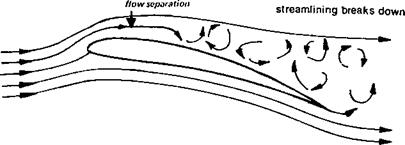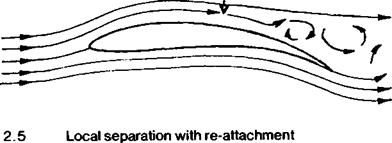WING CL AND TOTAL CL
Further difficulty is caused by the tailplane’s contribution to the aircraft Cl – In modelling for competition purposes, the tail area and wing area are both taken into account to prevent competitors from trying to gain unfair advantage in wing loading by fitting oversized tailplanes. (That there is any advantage is an illusion, but the rule was introduced long ago and is unlikely to be changed in the F. A.I. Sporting Code. Any area added to the stabiliser has to be taken away from the mainplane.) If the tail or canard forewing does contribute some lift to the total, the Cl of the whole model may be determined using the combined areas in the lift formula. In full-sized aeronautics die aircraft Cl is usually determined in terms of the wing area alone. This is a convention, no more. Various other conventions are adopted about the parts of wings and tails that are (geometrically) inside fuselages, or enclosed by engine nacelles, etc. What area is actually used in calculations is to some degree a matter of choice and convenience. Problems arise only if inconsistent conventions are adopted.
2.4 STREAMLINED FLOW
When the air meets any body, such as a wing, it is deflected over the surfaces. In accordance with Bernoulli’s theorem (see 2.12 below) above and below a wing there is a complex variation of velocity and pressure. For positive reaction, which is the basis of lift, there must be a positive difference in total pressures on top and bottom surfaces. The air over the upper surface is therefore made to flow over a longer route, so that it moves faster than that talcing a shorter route below. These effects are felt both ahead of and behind the wing. The flow ahead tends to be drawn upwards towards the low pressure region, which creates an upwash, and beyond the trailing edge it tends to return to its former position, so there is a corresponding downwash (Fig. 2.2). The pressure difference between the two surfaces may be increased up to a point by increasing the angle of attack, or increasing the camber or both. There is a very definite limit to this. If either the angle of attack or the camber is increased too much, the streamlining breaks down and the flow separates from the wing. This is explained in greater detail in Chapter 3. Flow separation not only creates a great deal of drag, but also changes markedly the pressure difference between upper and lower surfaces. The lift force is drastically reduced, the wing is stalled (Fig. 2.3).
Flow separation on a smaller scale is common. On the upper surface, flow may separate somewhere before the trailing edge, as sketched in Figure 2.4, or, as suggested in
|
Fig. 2.2 The origin of lift
|
|
Fig. 2.3 Stalling
|
|
wing partly stalled
|
|
Figure 2.5, there may on either surface or both be separation with subsequent reattachment. This is called ‘bubble separation’. Typical results of test on model wings are given in Chapter 8. |















